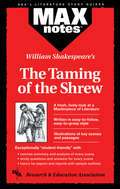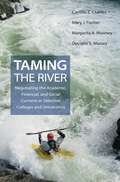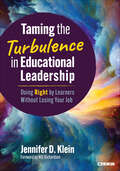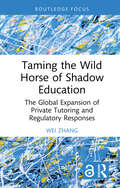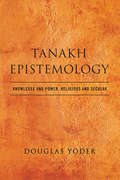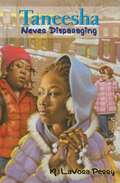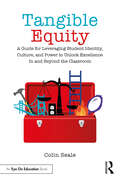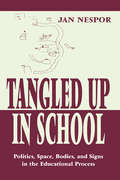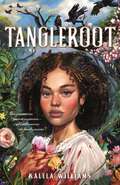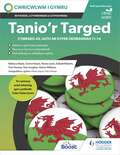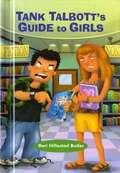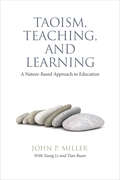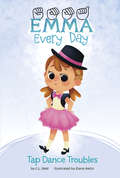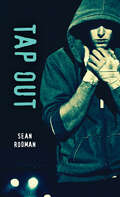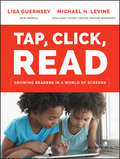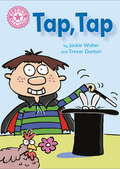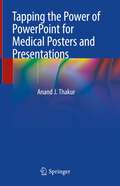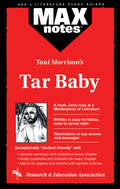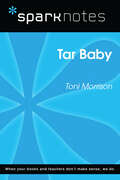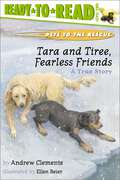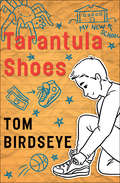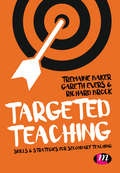- Table View
- List View
Taming of the Shrew, The (MAXnotes Literature Guides)
by Christopher GarcezREA's MAXnotes for William Shakespeare's The Taming of the Shrew The MAXnotes offers a comprehensive summary and analysis of The Taming of the Shrew and a biography of William Shakespeare. Places the events of the play in historical context and discusses each act in detail. Includes study questions and answers along with topics for papers and sample outlines.
Taming the River: Negotiating the Academic, Financial, and Social Currents in Selective Colleges and Universities (The William G. Bowen Series #51)
by Douglas S. Massey Mary J. Fischer Camille Z. Charles Margarita A. MooneyBuilding on their important findings in The Source of the River, the authors now probe even more deeply into minority underachievement at the college level. Taming the River examines the academic and social dynamics of different ethnic groups during the first two years of college. Focusing on racial differences in academic performance, the book identifies the causes of students' divergent grades and levels of personal satisfaction with their institutions. Using survey data collected from twenty-eight selective colleges and universities, Taming the River considers all facets of student life, including who students date, what fields they major in, which sports they play, and how they perceive their own social and economic backgrounds. The book explores how black and Latino students experience pressures stemming from campus racial climate and "stereotype threat"--when students underperform because of anxieties tied to existing negative stereotypes. Describing the relationship between grade performance and stereotype threat, the book shows how this link is reinforced by institutional practices of affirmative action. The authors also indicate that when certain variables are controlled, minority students earn the same grades, express the same college satisfaction, and remain in school at the same rates as white students. A powerful look at how educational policies unfold in America's universities, Taming the River sheds light on the social and racial factors influencing student success.
Taming the Turbulence in Educational Leadership: Doing Right by Learners Without Losing Your Job
by Jennifer D KleinLearner-centered leadership grounded in courage, integrity, and love for every child The pressures of today’s political and cultural climate have created unprecedented roadblocks for school leaders striving to ensure success for all students. With mounting challenges from communities, conservative legislation, and misconceptions about student-centered instruction and inclusion efforts, leaders often feel isolated and threatened in their efforts to prioritize what learners need most. Drawing on interviews with 67 education leaders around the world, Taming the Turbulence in Educational Leadership is a practical handbook, offering strategies to drive equity-focused and student-centered transformation, even in the face of opposition. Additional features include Approaches to foster trust and build relationships across the campus and community to overcome resistance Strategies to leverage data; include learner, teacher, and parent voices; and use intentional communication for effective decision-making Tools for preparing teachers, adapting systems, and protecting staff as they implement equity-centered initiatives Protocols, reflective questions, and worksheets to help schools determine readiness and create actionable plans Rooted in real-world stories, this book offers solidarity and actionable strategies to education leaders committed to centering the needs of all learners in increasingly polarized societies.
Taming the Turbulence in Educational Leadership: Doing Right by Learners Without Losing Your Job
by Jennifer D KleinLearner-centered leadership grounded in courage, integrity, and love for every child The pressures of today’s political and cultural climate have created unprecedented roadblocks for school leaders striving to ensure success for all students. With mounting challenges from communities, conservative legislation, and misconceptions about student-centered instruction and inclusion efforts, leaders often feel isolated and threatened in their efforts to prioritize what learners need most. Drawing on interviews with 67 education leaders around the world, Taming the Turbulence in Educational Leadership is a practical handbook, offering strategies to drive equity-focused and student-centered transformation, even in the face of opposition. Additional features include Approaches to foster trust and build relationships across the campus and community to overcome resistance Strategies to leverage data; include learner, teacher, and parent voices; and use intentional communication for effective decision-making Tools for preparing teachers, adapting systems, and protecting staff as they implement equity-centered initiatives Protocols, reflective questions, and worksheets to help schools determine readiness and create actionable plans Rooted in real-world stories, this book offers solidarity and actionable strategies to education leaders committed to centering the needs of all learners in increasingly polarized societies.
Taming the Wild Horse of Shadow Education: The Global Expansion of Private Tutoring and Regulatory Responses
by Wei ZhangZhang analyses the phenomenon of private supplementary tutoring from a global perspective. The expansion of such tutoring alongside schooling is among the striking global shifts since the turn of the century. In many countries over half of the relevant cohorts of children receive private tutoring, with that proportion in some locations exceeding 80%. The sector has far-reaching implications for social inequalities, (in)efficiencies in educational processes, study burdens on students, family finances, innovation, and employment. Yet greatly-needed government regulations have typically been slow to catch up with the phenomenon.Commentary in the volume juxtaposes countries with strong regulations with counterparts having weak regulations. Conceptually, the book considers forces changing the roles of multiple stakeholders, including governments, entrepreneurs, teachers, families and students.A useful read for students and researchers interested in comparative education and governance.
Tanakh Epistemology: Knowledge and Power, Religious and Secular
by Douglas YoderIn this volume, Douglas Yoder uses the tools of modern and postmodern philosophy and biblical criticism to elucidate the epistemology of the Tanakh, the collection of writings that comprise the Hebrew Bible. Despite the conceptual sophistication of the Tanakh, its epistemology has been overlooked in both religious and secular hermeneutics. The concept of revelation, the genre of apocalypse, and critiques of ideology and theory are all found within or derive from epistemic texts of the Tanakh. Yoder examines how philosophers such as Spinoza, Hume, and Kant interacted with such matters. He also explores how the motifs of writing, reading, interpretation, image, and animals, topics that figure prominently in the work of Derrida, Foucault, and Nietzsche, appear also in the Tanakh. An understanding of Tanakh epistemology, he concludes, can lead to new appraisals of religious and secular life throughout the modern world.
Taneesha Never Disparaging
by M. Lavora PerryTeased because of her choice of friends, her Buddhist religion, and her lackluster campaign for class president, Taneesha's fifth-grade school year proves to be disappointing until she learns to make peace with herself and those around her.
Tangible Equity: A Guide for Leveraging Student Identity, Culture, and Power to Unlock Excellence In and Beyond the Classroom
by Colin SealeMove beyond the "why" of equity and learn what it actually looks like in the classroom. This powerful book by bestselling author Colin Seale shows how you can overcome barriers and create sustainable pathways to realizing equity for your students. Part I of the book explains why all education stakeholders should not just prioritize equity, but go beyond the buzzwords. Part II looks at why good intentions aren’t enough, and provides six ways you can leverage your power to really start doing something about equity. Part III discusses the five classroom-level philosophical shifts needed to make real change, including how to think differently about gifted education and achievement gaps. Finally, Part IV offers a variety of practical strategies for making equity real in your classrooms, no matter what grade level or subject area you teach. Throughout each chapter, you’ll find stories, examples, and research to bring the ideas to life. With the concrete suggestions in this book, you’ll be able to overcome deficit models, focus on opportunities for academic success and educational justice, and make equity tangible for each of your students.
Tangled Up in School: Politics, Space, Bodies, and Signs in the Educational Process (Sociocultural, Political, and Historical Studies in Education)
by Jan NesporBased on two years of ethnographic fieldwork in an urban elementary school, this volume is an examination of how school division politics, regional economic policies, parental concerns, urban development efforts, popular cultures, gender ideologies, racial politics, and university and corporate agendas come together to produce educational effects. Unlike conventional school ethnographies, the focus of this work is less on classrooms than on the webs of social relations that embed schools in neighborhoods, cities, states, and regions. Utilizing a variety of narratives and analytical styles, this volume: * explores how curriculum innovations are simultaneously made possible by and undermined by school district politics, neighborhood histories, and the spatial and temporal organizations of teachers' and parents' lives; * situates the educational discourse of administrators and teachers in the changing economic and political climates of the city; * analyzes the motivations behind an effort by school and business proponents to refashion classrooms within the school into business enterprises, and of children's efforts to make sense of the scheme; * examines the role of the school as a neighborhood institution, situating it at the intersections of city planners' efforts to regulate city space and children's efforts to carve out live spaces through out-of-school routines; * contemplates the meaning of school as a site for bodily experience, and looks at how patterns of space and control in the school shaped children's bodies, and at how they continued to use body-based languages to construct maturity, gender, and race; and * investigates the school as a space for the deployment of symbolic resources where children learned and constructed identities through their engagements with television, comic books, movies, and sports. Tangled Up In School raises questions about how we draw the boundaries of the school, about how schools fit into the lives of children and cities, and about what we mean when we talk about "school."
Tangleroot
by Kalela WilliamsThe acclaimed INDIES INTRODUCE and INDIE NEXT debut YA novel about blood and family that is both history and mystery, perfect for fans of Angeline Boulley and Jesmyn Ward.★ "A gripping and heartbreaking debut." -- Kirkus Reviews, starred reviewNoni Reid has grown up in the shadow of her mother, Dr. Radiance Castine, renowned scholar of Black literature, who is alarmingly perfect at just about everything. When Dr. Castine takes a job as the president of the prestigious Stonepost College in rural Virginia, Noni is forced to leave her New England home and, most importantly, a prime internship and her friends. She and her mother move into the “big house” on Tangleroot Plantation. Tangleroot was built by one of Noni’s ancestors, an enslaved man named Cuffee Fortune—who Dr. Castine believes was also the original founder of Stonepost College, and that the school was originally formed for Black students. Dr. Castine spends much of her time trying to piece together enough undeniable truth in order to change the name of the school in Cuffee’s honor—and to force the university to reckon with its own racist past. Meanwhile, Noni hates everything about her new home, but finds herself morbidly fascinated by the white, slaveholding family who once lived in it. Slowly, she begins to unpeel the layers of sinister history that envelop her Virginia town, her mother’s workplace, her ancestry—and her life story as she knew it. Through it all, she must navigate the ancient prejudices of the citizens in her small town, and ultimately, she finds herself both affirming her mother’s position and her own—but also discovering a secret that changes everything.
Tanio'r Targed: Cymraeg Ail Iaith ar gyfer oedrannau 11–14
by Tina Thomas Rebecca Boyle Tudur Dylan Jones Nicola Lewis Dafydd Roberts Connor Keyes Keiron Williams Sian VaughanMae'r gwerslyfr hwn wedi'i gymeradwyo gan CBAC.Anogwch fyfyrwyr i ymgysylltu â'r Gymraeg wrth iddynt ddarganfod mwy am eu gwlad, eu llenyddiaeth a'u treftadaeth, tra'n datblygu'r sgiliau gwrando, darllen, siarad ac ysgrifennu sydd eu hangen ar gyfer TGAU.Wedi'i gynllunio gan dîm o arbenigwyr pwnc, mae'r Llyfr Myfyrwyr hygyrch hwn yn dilyn dull dysgu sy'n seiliedig ar sgiliau.- Darganfod cyfoeth o adnoddau a gweithgareddau newydd: bydd y cwrs un llyfr cost-effeithiol hwn yn helpu i ddatblygu dysgwyr uchelgeisiol a galluog ac ysbrydoli cariad at y Gymraeg- Helpu pob myfyriwr i symud ymlaen gyda chynnwys gwahaniaethol sydd wedi'i gynllunio i ddarparu ar gyfer lefelau amrywiol o wybodaeth a gallu- Archwilio diwylliant, hunaniaeth a llenyddiaeth Cymru gyda'ch myfyrwyr, gan weithio drwy weithgareddau difyr sy'n eu galluogi i gael hwyl gyda thafodiaith, ysgrifennu eu barddoniaeth eu hunain a dadansoddi dramâu- Datblygu dealltwriaeth myfyrwyr o ramadeg a geirfa ar draws gwahanol gyd-destunau gyda dull seiliedig ar sgiliau o siarad, gwrando, darllen ac ysgrifennu- Gosod sylfeini cadarn ar gyfer TGAU: mae cwestiynau yn arddull PISA, fideos, llenyddiaeth, sgiliau cyfieithu a sgiliau prawf ddarllen yn cael eu cyflwyno'n raddol, gan baratoi myfyrwyr ar gyfer cynnwys a mathau o gwestiynau TGAU- Cydweithio â'ch adrannau Saesneg ac ITM gyda nodiadau athrawon sy'n dangos cysylltiadau trawsgwricwlaidd.---This textbook has been endorsed by WJEC.Encourage students to engage with the Welsh language as they discover more about their country, literature and heritage, while developing the listening, reading, speaking and writing skills needed for GCSEDesigned by a team of subject specialists, this accessible Student Book takes a skills-based approach to learning.- Discover a wealth of new resources and activities: this cost-effective single-book course will help develop ambitious and capable learners and inspire a love of the Welsh language- Help all students progress with differentiated content designed to cater for varying levels of knowledge and ability- Explore Welsh culture, identity and literature with your students, working through engaging activities that allow them to have fun with dialect, write their own poetry and analyse plays= Develop students' understanding of grammar and vocabulary across different contexts with a skills-based approach to speaking, listening, reading and writing- Lay firm foundations for GCSE: PISA-style questions, videos, literature, translations and proofreading skills are introduced gradually, preparing students for GCSE content and question types
Tanio'r Targed: Cymraeg Ail Iaith ar gyfer oedrannau 11–14
by Tina Thomas Rebecca Boyle Tudur Dylan Jones Nicola Lewis Dafydd Roberts Connor Keyes Keiron Williams Sian VaughanMae'r gwerslyfr hwn wedi'i gymeradwyo gan CBAC.Anogwch fyfyrwyr i ymgysylltu â'r Gymraeg wrth iddynt ddarganfod mwy am eu gwlad, eu llenyddiaeth a'u treftadaeth, tra'n datblygu'r sgiliau gwrando, darllen, siarad ac ysgrifennu sydd eu hangen ar gyfer TGAU.Wedi'i gynllunio gan dîm o arbenigwyr pwnc, mae'r Llyfr Myfyrwyr hygyrch hwn yn dilyn dull dysgu sy'n seiliedig ar sgiliau.- Darganfod cyfoeth o adnoddau a gweithgareddau newydd: bydd y cwrs un llyfr cost-effeithiol hwn yn helpu i ddatblygu dysgwyr uchelgeisiol a galluog ac ysbrydoli cariad at y Gymraeg- Helpu pob myfyriwr i symud ymlaen gyda chynnwys gwahaniaethol sydd wedi'i gynllunio i ddarparu ar gyfer lefelau amrywiol o wybodaeth a gallu- Archwilio diwylliant, hunaniaeth a llenyddiaeth Cymru gyda'ch myfyrwyr, gan weithio drwy weithgareddau difyr sy'n eu galluogi i gael hwyl gyda thafodiaith, ysgrifennu eu barddoniaeth eu hunain a dadansoddi dramâu- Datblygu dealltwriaeth myfyrwyr o ramadeg a geirfa ar draws gwahanol gyd-destunau gyda dull seiliedig ar sgiliau o siarad, gwrando, darllen ac ysgrifennu- Gosod sylfeini cadarn ar gyfer TGAU: mae cwestiynau yn arddull PISA, fideos, llenyddiaeth, sgiliau cyfieithu a sgiliau prawf ddarllen yn cael eu cyflwyno'n raddol, gan baratoi myfyrwyr ar gyfer cynnwys a mathau o gwestiynau TGAU- Cydweithio â'ch adrannau Saesneg ac ITM gyda nodiadau athrawon sy'n dangos cysylltiadau trawsgwricwlaidd.---This textbook has been endorsed by WJEC.Encourage students to engage with the Welsh language as they discover more about their country, literature and heritage, while developing the listening, reading, speaking and writing skills needed for GCSEDesigned by a team of subject specialists, this accessible Student Book takes a skills-based approach to learning.- Discover a wealth of new resources and activities: this cost-effective single-book course will help develop ambitious and capable learners and inspire a love of the Welsh language- Help all students progress with differentiated content designed to cater for varying levels of knowledge and ability- Explore Welsh culture, identity and literature with your students, working through engaging activities that allow them to have fun with dialect, write their own poetry and analyse plays= Develop students' understanding of grammar and vocabulary across different contexts with a skills-based approach to speaking, listening, reading and writing- Lay firm foundations for GCSE: PISA-style questions, videos, literature, translations and proofreading skills are introduced gradually, preparing students for GCSE content and question types
Tank Talbott's Guide to Girls
by Dori Hillestad ButlerHaving agreed to get math tutoring and to practice writing over the summer to avoid flunking fifth grade, Tank learns some important lessons about both family and fighting while writing a boy's guide to understanding girls.
Taoism, Teaching, and Learning: A Nature-Based Approach to Education
by John P. MillerThe ancient Chinese philosophy of Taoism contains profound wisdom about the cosmos, nature, human life, and education. Taoism seeks to be in harmony with nature, and using it as a guide can help us live in a way that is healing to both ourselves and the planet. Taoism, Teaching, and Learning identifies key aspects of Taoist thought and highlights how these principles can promote a holistic approach to teaching and learning. In particular, this book offers educators guidelines and pedagogical examples for how to instil a perspective of interconnectedness into their classrooms. It sheds light on how philosophical Taoism articulates a vision of the universe and life that mirrors the actual realities of nature. Providing frameworks and methods for teaching and learning based on the interconnectedness of life, Taoism, Teaching, and Learning develops an inspiring vision for education and helps us to see our world in a deeply holistic and meaningful way.
Tap Dance Troubles (Emma Every Day)
by C. L. ReidClick. Clack. Tap, tap, tap. Emma just started dance lessons and is determined to learn the routine perfectly. But dance isn't as easy as she had hoped. Thankfully Emma doesn't give up easily! Emma proves that hard work and practice will take those tap dance troubles away in this early chapter book from the Emma Every Day series. Emma is Deaf and often uses sign language to communicate, and each book includes an ASL fingerspelling chart, a sign language guide, a glossary, and content-related questions.
Tap Out (Orca Soundings)
by Sean RodmanWhen Darwin's father went to prison for assault, his mom decided it was time to move him from his inner-city school to the elite Norfolk Academy. It was supposed to be a brand-new start for him. But old instincts die hard, and Dar is used to fighting for everything. Convinced by a new friend to take part in an illegal fight club, Dar starts competing in no-holds-barred matches between students. He quickly rises to become the best in the ring. When one match goes too far and a student is almost killed, Dar faces a choice. Everyone tells him he's a fighter, but he needs to decide for himself--who is he, and what is he fighting for?
Tap, Click, Read
by Lisa Guernsey Michael H. LevineWith young children gaining access to a dizzying array of games, videos and other digital media, will they ever learn to read? The answer is yes - if we ensure that the media at children's fingertips is harnessed to promote the skills and knowledge that enable reading, instead of undermining them. Tap, Click, Read helps educators and parents become more successful at supporting young children's early literacy skills in the "digital wild west." With compelling text, videos, and interactive graphics, the book answers such questions as: In what ways could new technologies promote the adult-child interactions that help children develop language and literacy skills that help them become strong readers? Who are the pioneers in this field? What will it take to create a future in which parents and teachers become adept at using media to build a foundation for children's reading? Beyond traditional literacy, what are the digital competencies that today's young children will need to master in an increasingly complex and interconnected world? The authors provide findings from an ongoing examination of the app marketplace that identifies bright spots and pitfalls--a first-of-its-kind analysis, providing statistics on what kind of reading and other early learning apps are on offer in the free-for-all of the Apple app store and Google Play marketplaces. They also provide toolkits (such as e-media resource lists and community audit worksheets) for schools and community organizations to use as they foster literacy-focused relationships with parents and build high-tech learning spaces for tomorrow's readers. Rather than telling parents and teachers to push technology to the margins, Tap, Click, Read shows them how to put technology to work in serving children's needs and helping to address the crippling problem of low reading skills across the country.
Tap, Tap: Independent Reading Pink 1B (Reading Champion #95)
by Jackie WalterReading Champion offers independent reading books for children to practise and reinforce their developing reading skills.Fantastic, original stories are accompanied by engaging artwork and a reading activity. Each book has been carefully graded so that it can be matched to a child's reading ability, encouraging reading for pleasure.Independent Reading Pink 1B stories are perfect for children aged 4+ who are reading at book band 1B (Pink) in classroom reading lessons.In this story, Ben magics up a hat - and then all sorts of animals! Wherever can he keep them all?
Tapping the Power of PowerPoint for Medical Posters and Presentations
by Anand J. ThakurThis book talks about developing and improvising upon medical presentations by equipping readers with critical technical tips and tricks to use popular presentation programs like PowerPoint or Keynote effectively. The book details numerous remedial measures for qualitative improvement of average medical presentations. It has three sections: first covers the general aspects of preparing a presentation; the second provides practical details and refinements of preparing a medical presentation; the last section deals with niceties of podium and webinar presentations. The chapters cover many serious mistakes and remedial measures to improve average medical presentations, such as a description of purposeful use of colors in a slide, a brief discourse on technicalities of appropriate clinical image formats for projection ensues; the use of drawing and photo-editing programs to inject excellence in the contents of a medical presentation to help it stand out in the crowd, details on the importance of lexical correctness- typography, line spacing and alignment to enhance the impact of the presented text and many more. Several short videos support and actively promote the viewpoints discussed in the text. This book elaborates on the exquisite art of creating remarkable medical presentations for a specialized audience. This book is a must-have for all healthcare professionals of all specialties and grades who make podium presentations in a medical conference webinar or submit posters for display.
Tar Baby (MAXnotes Literature Guides)
by Ann WilsonREA's MAXnotes for Toni Morrison's Tar Baby MAXnotes offer a fresh look at masterpieces of literature, presented in a lively and interesting fashion. Written by literary experts who currently teach the subject, MAXnotes will enhance your understanding and enjoyment of the work. MAXnotes are designed to stimulate independent thought about the literary work by raising various issues and thought-provoking ideas and questions. MAXnotes cover the essentials of what one should know about each work, including an overall summary, character lists, an explanation and discussion of the plot, the work's historical context, illustrations to convey the mood of the work, and a biography of the author. Each section of the work is individually summarized and analyzed, and has study questions and answers.
Tar Baby (SparkNotes Literature Guide Series)
by SparkNotesTar Baby (SparkNotes Literature Guide) by Toni Morrison Making the reading experience fun! Created by Harvard students for students everywhere, SparkNotes is a new breed of study guide: smarter, better, faster. Geared to what today's students need to know, SparkNotes provides: *Chapter-by-chapter analysis *Explanations of key themes, motifs, and symbols *A review quiz and essay topicsLively and accessible, these guides are perfect for late-night studying and writing papers
Tara and Tiree, Fearless Friends: A True Story (Ready-to-Read Level 2) (Pets to the Rescue)
by Andrew ClementsBeginning readers will love reading about the true story of Tara and Tiree, two dogs who saved their owner's life. This Level 2 Ready-to-Read is sure to be a hit with pet lovers!Jim loves to go for long walks with his dogs, Tara and Tiree. One cold winter day, Jim falls through the ice on the frozen lake. Tiree tries to save him and falls through the ice too. What will happen if Tara tries to help them both?
Tarantula Shoes
by Tom BirdseyeDesperate to have the right shoes to start his first day of middle school, Ryan has set his sights on the $125 Slam Dunk Sky Jumpers—but can he put together the money in time?Ryan O&’Keefe can&’t believe his bad luck. Moving to a new state right before sixth grade is hard enough, but when he finds out that sixth grade is part of middle school in Kentucky, he realizes he may have to spend the year getting picked on by the older students. When he meets a couple of seventh graders wearing Slam Dunk Sky Jumpers, the coolest new shoes, Ryan knows he has to have a pair, and then maybe he&’ll be cool too. There&’s just one problem: The shoes are $125—plus tax! Ryan&’s parents give him forty dollars, so now all he has to do is come up with eighty-five more and the shoes are his. The only question is, how is he going to get eighty-five dollars in the remaining week before school starts?
Targeted Teaching: Strategies for secondary teaching
by Tremaine Baker Gareth Evers Richard BrockThere is no single best approach in teaching. This new text challenges the idea that there is a 'best way' to teach. Instead, the authors explain, a more pragmatic approach is required. Teachers need a range of skills and strategies to select from, work with and adapt. Every school, cohort, class and child is different. Beyond that, strategies that worked well with a class one week, may prove ineffective the next. This book: presents a range of strategies, well grounded in research, for trainees and beginning teachers to use in their own classroom settings and contexts presents a model of teaching that views teaching not as a profession in which there is always a single correct answer, but as a complex interaction between teacher and students addresses common issues that beginning teachers face when developing their practice If you are a teacher wanting to find out what works best for your class, in your school, right now, this text will show you how to harness the power of small or large scale research to help you find the answer.
Targeted Teaching: Strategies for secondary teaching
by Tremaine Baker Gareth Evers Richard BrockThere is no single best approach in teaching. This new text challenges the idea that there is a ′best way′ to teach. Instead, the authors explain, a more pragmatic approach is required. Teachers need a range of skills and strategies to select from, work with and adapt. Every school, cohort, class and child is different. Beyond that, strategies that worked well with a class one week, may prove ineffective the next. This book: presents a range of strategies, well grounded in research, for trainees and beginning teachers to use in their own classroom settings and contexts presents a model of teaching that views teaching not as a profession in which there is always a single correct answer, but as a complex interaction between teacher and students addresses common issues that beginning teachers face when developing their practice If you are a teacher wanting to find out what works best for your class, in your school, right now, this text will show you how to harness the power of small or large scale research to help you find the answer.
